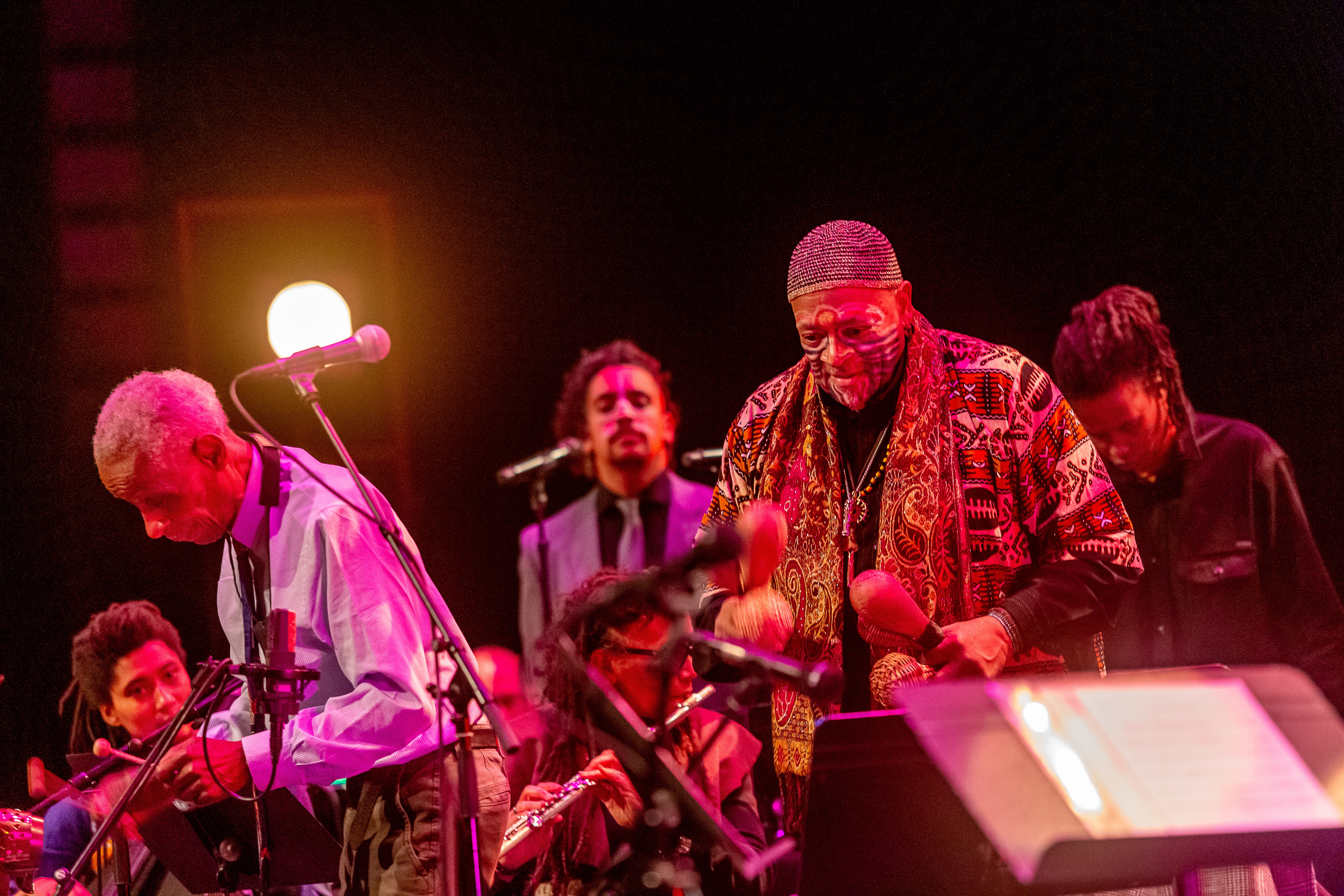You can’t spell “brand” without “band,” and in music the two words are implicitly combined; bands are brands, the name conjuring not just songs and albums, but a specific style and sound. Whether mutable like The Beatles or static, like The Rolling Stone, name the band and their sound immediately springs to life in your head.
This applies to jazz, even as there’s hardly any actual standing bands left—the economics of the music no longer supports longstanding groups of any size. Where the Miles Davis Quintets and big bands led by Ellington and Basie used to be on a payroll and tour regularly even while not recording albums, ensembles in the 21st century come together for recording sessions or short tours, even one-off concerts, then each player goes their separate way onto the next gig or pickup opportunity. Zooid, Jason Moran’s Bandwagon, The Cookers, and others are nominal bands, existing in the moment of performance but consisting of freelance musicians who try and work together toward the same purpose with some frequency.
That purpose is the key and is a question for two of the better known band names in jazz, each with a recent recording of a new configuration: The Bad Plus and the Art Ensemble of Chicago. From two very different eras and generations of musicians, each has been so important in shaping modern jazz that the music would be hard to imagine without their presence. In the fall of last year came The Bad Plus on Edition records (confusingly, this is the second album by the group titled eponymously—the first was their 2001 debut on Fresh Sound New Talent, and to add to the confusion, this album is also available under the title Motel), and in January, Rogue Art issued The Sixth Decade From Paris to Paris, a 2-CD concert album recorded February 7, 2020 at Sons D’Hiver, where an altogether different form of this band debuted in 1969.
On their debut, The Bad Plus was pianist Ethan Iverson, bassist Reid Anderson, and drummer Dave King, and played things like ABBA’s “Knowing Me Knowing You” and “Blue Moon” with a sarcasm that was rare in jazz and owed a lot to the legacy of the grunge movement. That connection came through with utmost sincerity in their arrangement of “Smells Like Teen Spirit,” which was the track on their 2003 major label debut, These Are The Vistas, that launched them into public consciousness. If one track can signal a band’s importance, it’s that one; on an album crafted like a rock record, they hauled the jazz songbook into the 21st century and played absolute jazz absolutely like a rock band. It’s one of the essential albums in jazz.
Iverson left at the end of 2017, replaced by Orrin Evans, and it was still the same band. The main trade was Evans’ subtlety for Iverson’s frequent intellectual fussiness, less rock and more jazz feel. Through two albums, it was clear the band sound came out of Anderson and King. But the latest version is far different. Now a quartet, the piano chair is gone and saxophonist Chris Speed and guitarist Ben Monder are in the mix. Same name, not the same band.
The record itself is fine, Speed and Monder are sensitive players with strong personalities, the rhythmic profile is strong but has lost some of the flavor of the original band. It is also impossible to avoid a fair comparison with Jim Black’s AlasNoAxis band, the same kind of jazz-rock band with Speed also on tenor. Tracks like “You Won’t See Me Before I Come Back” and “Sick Fire” are stylistic siblings to AlasNoAxis, but The Bad Plus is much more expressively transparent, without the intriguing but unsettling ambiguity of the other band, and even of the earlier version of The Bad Plus. Little more than the name remains the same.
The Art Ensemble of Chicago has long been one of the most important groups in the history of jazz, a collective improvisational ensemble that represented Chicago’s Association for the Advancement of Creative Musicians and the larger Black Arts Movement in general. They played free jazz, large-scale abstract compositions, soul, reggae and more, always exploring what Joseph Jarman (one of the founders) would exclaim at the end of performances as “great Black music, ancient to the future.” The AECO had an unmistakable sound and style for near three decades, before losing trumpeter Lester Bowie and bassist Malachi Favors to cancer and Jarman to age and ill-health, leaving remaining core members Roscoe Mitchell and Famoudou Don Moye.
Mitchell and Moye are the headliners on the new album, surrounded by a small orchestra of musicians, and older AECO compositions like “Leola” are on the album, but this is not the AECO, it’s further from the original than the new version of The Bad Plus is from its own roots. Not that this is bad, this is beautifully recorded concert with rich ensemble sounds and a lovely shape to the performance. But this is a Moor Mother album, her voice and poetry dominate everything, the music is centered around her recitations. Her texts look backward on history, describing and defining the traditions that support the free music being played. Bowie’s and Jarman’s sly wit have long been missed, along with their embrace of the popular strands of Black music—Moor Mother herself works deep within those, but that’s not here.
This Art Ensemble is less about “ancient to the future” than about itself, the past of the band. While the music making is terrific, the concept is inherently flawed, there’s the real danger of nostalgia undercutting the very point of free music. A legacy concert out of touch with the core of that legacy means “ancient to the future” becomes just a slogan, a piece of branding. As Franco Berardi describes in After the Future, once expectations of the future come to pass, we’re lost to nostalgia. There’s no more actual future, something that’s possible but unknowable, just preservation, putting once revolutionary music under glass and repeating if for comfort. It’s philosophically and morally no different than an orchestra playing Beethoven’s Symphony No. 3, which is not what jazz (especially the free side) is supposed to be about. Nostalgia has been the creeping danger in jazz almost since its beginnings, an anchor that threatens to drag the music back to an imagined prelapsarian moment and fix it there, curtailing both invention and contemporary language. This has done real damage to the music in the past, especially the heyday of Wynton Marsalis, in his reactionary phase, as the public face of jazz and Stanley Crouch as head intellectual ideologue.
Toward the end of the concert, the ensemble brings out two old mainstay themes, “Funky AECO” and “Odwalla.” It’s odd to hear them, they seem like obligatory demonstrations that this is indeed the AECO brand and trigger seductive pangs of nostalgia. “Funky AECO” is just the ensemble playing, and that’s good in and of itself, this is a tremendous collective of musicians. The AECO used “Odwalla” in concert as a coda, announcing that final note was approaching and as a space within which to introduce all the musicians. When Jarman was still alive, he would close this out with his “ancient to the future!” declamation and the band would cook it all out to the end, leaving you looking ahead to the next day, year, decade of possibilities, a colon in a sentence followed by a space to fill with an endless list. At the end of this concert, it sounds like a period, the finality of bringing an older legacy to life in front of an audience, but then putting it away again, preserved and in storage.
Author
-

George Grella wrote the book on Miles Davis’ Bitches Brew. He write other stuff too. killyridols.substack.com/
View all posts
George Grella wrote the book on Miles Davis’ Bitches Brew. He write other stuff too. killyridols.substack.com/










